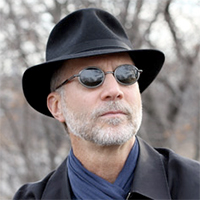
The San Francisco Contemporary Music Players began its season Monday at Herbst Theatre with a new guiding light, some new and old music, and several challenges to both brain and ear. The result was intriguing, carefully performed, and evocative at the core — despite problematic packaging.
Conductor, percussionist, professor, and Iowan, SFCMP’s new Artistic Director Steven Schick bubbled with enthusiasm and “What’s-that-again?” catchphrases as he introduced two friends and their works during the preconcert introduction. These composers, Josh Levine and John Luther Adams (not to be confused with the John Coolidge Adams of Dr. Atomic fame), had works on the docket that were almost opposite in character but equally demanding of listeners.
Levine’s piece was Transparency (Part I) for bass drum and triangle, with a few swishes of sandpaper thrown in at the conclusion. Writing solely for these instruments is like trying to write a novel using only the words boom, thud, and ting, yet Levine brilliantly made the most of their limitations. Moreover, he imposed additional ones: No funky rhythms or fancy “extended techniques” allowed. This focused attention on timbre alone, and Levine proved there is much subtlety to be heard from this seemingly Johnny-one-note percussion pair.
The composer described Clouds of Forgetting, Clouds of Unknowing as “an attempt to consecrate a small time and space for extraordinary listening.”
Smartly, he just wrote a short story rather than a novel: Seven minutes was precisely the right amount of time for Daniel Kennedy to expertly negotiate Levine’s essay in dynamics (big bangs to hand rubs), drum rolls, mallet changes, and, in the last half, experiments with four sizes of triangles.
Adams’ work, by contrast, was eight times longer, with 17 times as many performers, yet far less exploitive of dynamics. The composer described Clouds of Forgetting, Clouds of Unknowing as “an attempt to consecrate a small time and space for extraordinary listening.” By eschewing melody and muddying up harmony, the two elements of music he considered “figure” and “ground” as in Renaissance painting, Adams hoped his listeners would “lose perspective,” “become lost” in a “vast landscape,” as he said. Instead of figure and ground, Adams focused instead on “a few elementally simple sonorities and gestures.”
Mapping the Territory
I’m not sure if my experience would disappoint Adams or not, but I found his “simple” gestures to be excellent maps to his territory. Part of the interest was in not getting lost. His music, unlike that of others of the “Holy Minimalist” school, was not meditative in the sense that a listener should go into a trance and wake up refreshed, ignoring the sounds while letting them sink into the subconscious. Rather, its signposts kept one awake and actively anticipating their reappearance.
The chief signpost was a pregnant pause, at least eight of them, which delineated sections, each of which seemed to contain a similar sequence of procedures, the predictability and anticipation of which provided guidance and comfort.
“Difficult on the listener” certainly trumps age of repertoire, as far as the history of programming goes for this organization.
These included arpeggiated notes in the piano (the number of which regularly increases till it reaches 12 or 13 at the end), followed by a series of sonorities, often accompanied by tremolo, especially in the vibraphone. Furthermore, each section seemed to begin on a higher note. At the end, the progression was summarized by a gradual run up the 12-note chromatic scale till the octave was reached.
The affect of the music was not as pleasant as the mental engagement, however. Many of the sonorities had high harmonics in the strings on top of dense, gray chords. The pace was slow, with generally few rhythmic sources of energy. The arpeggiations (and tremolos) were unrelenting: More than a barcarolle, they became like a nightmare, a nontriadic “Moonlight Sonata” of Beethoven, with the left-hand accompaniment treading over and over like Frankenstein’s monster. The result came to me strongly as an image of Charon, at an agonizingly slow pace, taking doomed souls across a frozen Styx floodplain in a creaky old wagon.

Thankfully, conductor Schick used a whip on this tortoise. He was able to finish the work, billed as 65 minutes long, in only 59. The other side of the Styx was received moderately, but warmly, by the audience, completing the 90-minute program.
The central eight minutes of the evening was devoted to the most popularly received piece on the program, Edgard Varèse’s Octandre, wonderfully performed by the SFCMP. But why is there a C in this acronym? The piece, physically shocking as it still can be in its extreme level of dissonance, was written in 1923. For that matter, even Adams’ opus was finished more than 15 years ago. Is this “contemporary”? At least Levine’s 2004 piece was revised in 2010. I realize it is far too late to change the name of a revered institution, but considering the type of music preferred by this essential component of the San Francisco musical community, it should be called the DMZ, the Difficult Music Zone. With a few exceptions, “Difficult on the listener” certainly trumps age of repertoire, as far as the history of programming goes for this organization.
After all, Schick has labeled each concert this season a Zone. Monday’s “Zone 1” was the one, according to the artistic director, “in which crisscrossing vectors enliven the ear and oxygenate the sonic space.” Challenging listeners is one thing, but denying the laws of physics and chemistry is another. Fortunately, the next concert, if more mysterious, will not offend scientists. In Zone 2, an “indispensable morphology” will be identified.
Can’t wait!

